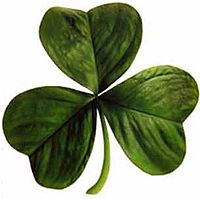 (image source)
(image source)Here's a study of Patrick's life that asks about a key:
why just is Saint Patrick nearly always shown with a shamrock? Apparently he tried to explain the concept of the Holy Trinity to some Irish pagans. Who simply could not get their heads around the conflicting messages that there is but one God, but that He is a Trinity at the same time.
So Patrick plucked a shamrock and used this to exemplify the Holy Trinity. "Look, it is made up of three identical yet separate pieces - and those three pieces do not exist in isolation but are one." The Irish got the message and the shamrock became a national symbol.
 (image source)
(image source)But should you be a pagan, this might interest you:
It's unclear how rare four-leaf clovers are. A clover farmer interviewed in 2005 estimated that 1 in 10,000 shamrocks have four leaves, while lower estimates put the ratio closer to 1 in 100.
Edward Martin Sr., of Cooper Landing, Alaska, holds the record for collecting the most four-leaf clovers. Since he began gathering them as a child growing up in Brooklyn, N.Y, he's found 160,000.
He usurped the previous record holder George Kaminski, an inmate in a Pennsylvania prison who took the title in 1995 after finding 72,927 four-leaf clovers in prison yards.
 (image source)
(image source)Irish PM Bertie Ahearn has George Bush covered:
"There's no reason (why) people can't enjoy themselves and be part of the celebrations without going over the top," Ahern said in Washington, where he was presenting President Bush with a ceremonial bowl of shamrocks.As for Wikipedia:
Police said a record 650,000 revelers gathered up to 20 deep on the sidewalks of central Dublin for the annual parade, the biggest event in Ireland's five-day St. Patrick's Festival. Many brought ladders or balanced precariously on security fences, garbage bins and statues to see the spectacle, which was led by a mammoth float of St. Patrick on a Harley-Davidson motorcycle.
The shamrock, a symbol of Ireland and a registered trademark of the Republic of Ireland,[1] is a three-leafed old white clover, sometimes (rarely nowadays) Trifolium repens (white clover, known in Irish as seamair bhán) but more usually today Trifolium dubium (lesser clover, Irish: seamair bhuí). The diminutive version of the Irish word for "clover" ("seamair") is "seamaróg", which was anglicised as "shamrock", representing a close approximation of the original Irish pronunciation. However, other three-leafed plants — such as black medic (Medicago lupulina), red clover (Trifolium pratense), and Common wood sorrel (genus Oxalis) — are sometimes designated as shamrocks. The shamrock was traditionally used for its medical properties and was a popular motif in Victorian times. It is also a common way to represent St. Patrick's Day. Shamrocks are said to bring good luck.Happy Patrick's day!

No comments:
Post a Comment